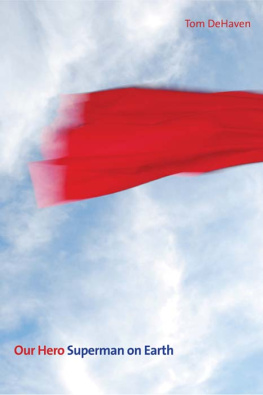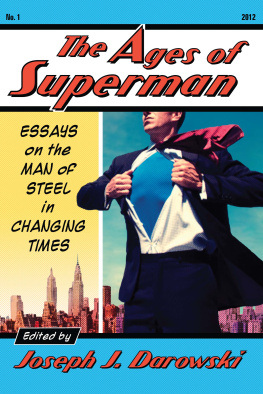Copyright 2010 by Tom De Haven.
All rights reserved.
This book may not be reproduced, in whole or in part, including illustrations, in any form (beyond that copying permitted by Sections 107 and 108 of the U.S. Copyright Law and except by reviewers for the public press), without written permission from the publishers.
Set in Janson type by Tseng Information Systems, Inc. Printed in the United States of America.
A catalogue record for this book is available from the British Library.
This paper meets the requirements of ANSI/NISO Z39.48-1992 (Permanence of Paper).
Icons of America
Mark Crispin Miller, Series Editor
Icons of America is a series of short works by leading scholars, critics, and writers on American history, or more properly the image of America in American history, through the lens of a single iconic individual, event, object, or cultural phenomenon. Other titles in the series include:
Alger Hiss and the Battle for History, by Susan Jacoby
Andy Warhol, by Arthur C. Danto
The Big House, by Stephen Cox
Frankly, My Dear: Gone with the Wind Revisited, by Molly Haskell
Fred Astaire, by Joseph Epstein
Gypsy: The Art of the Tease, by Rachel Shteir
The Hamburger: A History, by Josh Ozersky
Inventing a Nation: Washington, Adams, Jefferson, by Gore Vidal
Kings Dream, by Eric J. Sundquist
Nearest Thing to Heaven: The Empire State Building and American Dreams,
by Mark Kingwell
Small Wonder: The Little Red Schoolhouse in History and Memory, by Jonathan Zimmerman
Wall Street: Americas Dream Palace, by Steve Fraser
Forthcoming titles include:
Toni Bentley on George Balanchines Serenade
Kyle Gann on John Cages 433
To Santa
still the same
Acknowledgments
I would like to thank Art Spiegelman for suggesting me for this project, and the legion of writers who have tackled Superman the Icon before me, especially Thomas Andrae, Michael Citron, Tom Crippen, Les Daniels, Michael Eury, Jules Feiffer, Michael Fleisher, Robert C. Harvey, Gerard Jones, Jake Rossen, Bruce Scivally, Jim Steranko, James Vance, Bradford C. Wright, and Craig Yoe; without their trailblazing, even groundbreaking, work, Our Hero would not have been possible. To Nicky Brown I am much indebted for assistance in writing about her remarkable grandfather, Major Malcolm Wheeler-Nicholson.
For their suggestions, tips, referrals, and support, many thanks as well to John Beckman, Laura Browder, Russell Dunn, Steve Dunn, Jackie Estrada, Michael T. Gilbert, Elizabeth Hand, Tom Inge, Christopher Irving, Elizabeth Kaplan, Batton Lash, Amanda Matetsky, Harry Matetsky, Eric Reynolds, Mark Svensson, Roy Thomas, and Kristy Valenti.
Finally, I want to express my deep gratitude to the Eastern Frontier Educational Foundation for offering me summer residencies on Norton Island, Maine (the coolest place on earth), where much of this essay was drafted, and to my great and generous friend Faye Prichard (mayor of Ashland, Virginia, the center of the universe) for her editorial input and bibliographic expertise.
Our Hero
1
Over a span of three weeks in late spring 2006, I spent some part of almost every day on the telephone being asked and answering questions about Superman, Superman, Superman. Mostly it was newspapers and press services calling me, but a few radio stations did too, even a couple of podcasts. Superman Returns, the Bryan Singer movie starring Brandon Routh, was set to open in ten bazillion theaters worldwide, and American media were generating feature stories galore in breathless, complicit anticipation. But why call me for some (hopefully) pithy and (possibly) illuminating commentary about the character and the upcoming movie (about which I personally knew nothing)? Because half a year earlier, Chronicle Books had published a novel Id written about Superman, my version of Superman, and that, somehow, qualified me as an authentic Superman expert. Flattering to be so considered, but not really the case. Its Superman! had nothing to do with Singers film, or with the Smallville television program, or with the Warner Brothers animated cartoon series, or even, for that matter, with the monthly Superman comic books. With the permission and approval of DC Comics (but without any input or strictures), Id set my story during the Great Depression and placed Superman back in his original 1930s contexthis first appearance was in Action Comics number 1, published in late spring 1938. The fun for me had been to imagine the Man of Steel physically and morally, even politically, as hed been portrayed at the start by Jerry Siegel and Joe Shuster, the two teenagers from Cleveland who created him. Written in noirish meter without too much kidding around, it was (yet another bildungsroman) about the farm boy Clark Kent once he discovers hes stronger than anyone else. And can fly. Its Superman! had been widely reviewed, so my name kept popping up during database searches for Superman authorities.
Although I dont enjoy being interviewed and Im not savvy at itI tend to meanderI almost never (okay: I never) turn down a request for one. Who doesnt like seeing his name in print or hearing her prerecorded voice on the radio, even when half the time you come off sounding like a real knucklehead? Besides, its self-promotion. I could sell a few books, maybe. Its a theory, at least.
What I kept being asked pretty much boiled down to three questions, usually asked in the same order. Why has Superman lasted for almost seventy years? Can you explain his appeal? Does he still matter in the twenty-first century?
For the first two questions I had decent answers, I thought, despite their sounding canned by the last few interviews. Why has Superman lasted? To begin, he has the solid advantage of being the first comic book superhero. Cachet right thereno? But really, its the premise. You cant beat it. Doomed planet, sole survivor, secret identity, Earths mightiest hero. Beautiful. And its simplicity has enabled hundreds of writers (comics writers, screenwriters, songwriters, librettists, poets, novelists, bubble-gum-card miniaturists) working over a period of seven decades to dream up tens of thousands of Superman narratives.

Brandon Routh, skinny Man of Steel, in Bryan Singers Superman Returns, 2006 (PhotoFest Digital, DC Comics)
Superman is forever a work in progress, changing, sometimes subtly, other times radically, but normally (not always, but normally) in ways that have kept him popular, to greater or lesser degrees, for several generations. At the same time, certain parts of his makeuphis essence, the crux of himhave never altered. Or when they have, corrections soon have been made, his integrity reconfirmed.
No matter the incarnation, Superman is a hardworking guy who gets things done. Whatever he puts his mind to. Hes John Henry without the steam-drill competition and the fatal heart attack. As Tom Crippen, writing in the







